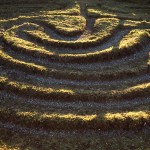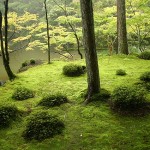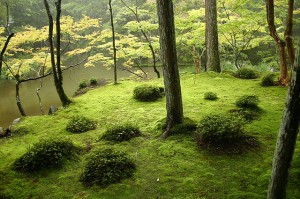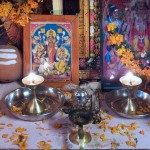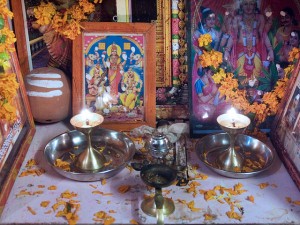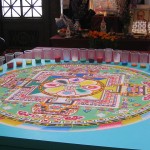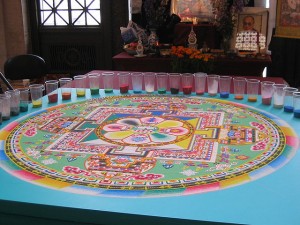Walking the labyrinth is a very ancient form of meditation, very relaxing, and it’s well worth giving it a try. It’s very personal and inwardly focussed, and yet shared with your fellow-travellers in a wordless communion.
Each person’s journey into the labyrinth is unique, although the labyrinth has a single pathway to the centre. We all travel on the same pathway, but each person goes at a different speed, travelling in a different way. Rather like life, the path twists and turns, in and out, and you never know how close to the centre you are. When the path appears to take you furthest away from the centre, you are nearer, and when you appear to be closest, you are actually further away.
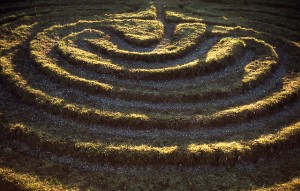
The centre – the goal of the journey – can mean different things to different people. For me, it is a metaphor for the Divine: always present, always hidden. In Pagan labyrinths, the centre symbolises the underworld, the inner realm; in Christian labyrinths, it represents the goal of the pilgrim, Jerusalem, with Christ at the centre.
The centre is a place to meditate and reflect on the journey, connect with the Divine, or just look into yourself. The space at the centre is shaped like a flower, or like the rose window of a cathedral. Each of its petals represents one of six kingdoms: mineral, vegetable, animal, human, angelic and the unknown.
The journey back from the centre depicts bringing back the blessing and insight from the other realm to share with your community. As you cross the threshold once more into the outer world, it is a good idea to meditate on the experience, and only gradually ease back into normal conversation.
Pagan labyrinths generally have the path winding through one quadrant at a time, possibly so the walker can meditate on each of the four elements in turn. Christian labyrinths have the path winding back and forth between the quadrants, so that you never know where you are. This is in many ways a more powerful experience, because you never know how close you are to the goal of the journey, so it is a revelation when you reach it. One such labyrinth is the one in Chartres Cathedral, which was constructed around 1200.
The oldest labyrinth design is the Cretan labyrinth, which is a very simple design and can be drawn quite quickly; it is easy to make out of pebbles in your garden or at a camp.
A brief history of mazes and labyrinths
Mazes are recorded in Egypt, Rome, Scandinavia, England, India, and the American Southwest. They are generally believed to symbolise the soul’s journey through life, or the journey of the dead to the underworld.
There are two types of maze: the unicursal (single path) maze and the puzzle maze. Both of these are referred to as both a labyrinth and a maze. However, in the myth of the Minotaur, the labyrinth in which the Minotaur dwells is clearly a puzzle maze (i.e. having dead ends), as Theseus needs a thread to find his way through to the centre. Apparently the legend of Theseus and the Minotaur refers to the maze-like palace at Knossos, which burned to the ground in the 15th century BCE.
The Classical Maze comes in four types, the Serpentine, Spiral, Simple Meander, and Complex Meander. The Roman ones were usually square, but these designs work as circular mazes too.
The principle of the maze was probably discovered in the Neolithic. The earliest recorded mazes were in Crete, 4000 years ago. In Egypt, there was a huge palace complex on the shores of a lake seven days journey up the Nile from the pyramids in form of a labyrinth. This was built by pharaoh Amenemhet III in the 19th century BCE. It consisted of thousands of rooms and twelve large maze-like courtyards, which were probably intended to keep out unwelcome visitors. Amenemhet also created a maze inside his nearby pyramid to thwart tomb robbers. Most Roman labyrinths, on the other hand, were too small to have been walked, and are typically found on the floor near the entrances to houses and villas; many have small city walls (perhaps indicating the walls of Troy) drawn around them. This suggests they served a protective function, and were perhaps believed to have warded off evil influences or intruders — a common function of the labyrinth in many other cultures as well. The tomb of Lars Porsenna (an Etruscan king) at Chiusi in Italy was said to be surrounded by a labyrinth.
The turf mazes of Britain and Scandinavia may have served a similar purpose, but in the Middle Ages they acquired an additional association with May games; hence the name “Robin Hood’s Race” or “Julian’s Bower”. The Celtic name for a maze was Caer Droia, the place of turning, and this was transliterated into English as Troy Town. It was widely believed that England was founded by Brutus fleeing Troy, and the mazes were believed to represent Troy. Mazes in Finland were often called Jericho, referring to the legend that it was destroyed by the Israelite army marching around it seven times. A maze called ‘the walls of Jericho’ also appears in a Hebrew manuscript.

